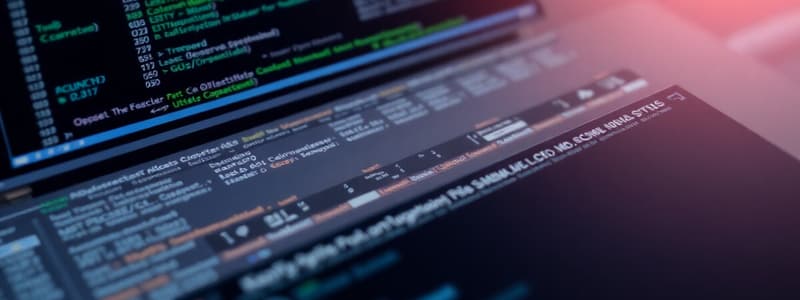Podcast
Questions and Answers
What role does the operating system play in relation to application software?
What role does the operating system play in relation to application software?
- It replaces the need for any application software.
- It installs application software on hardware devices.
- It provides a platform for applications, ensuring compatibility. (correct)
- It runs applications directly without user interaction.
Which of the following is NOT a key function of an operating system?
Which of the following is NOT a key function of an operating system?
- Memory Management
- File Management
- Interrupt Handling
- Internet Browsing (correct)
How does multitasking work within an operating system?
How does multitasking work within an operating system?
- It prevents user interaction with inactive programs.
- It allocates a time slice of processor time to each program. (correct)
- It allows all programs to run simultaneously without delay.
- It requires a special type of hardware for execution.
What is the purpose of file extensions in an operating system?
What is the purpose of file extensions in an operating system?
Which statement accurately describes device drivers in an operating system?
Which statement accurately describes device drivers in an operating system?
What advantages do roaming profiles offer to users in a networked environment?
What advantages do roaming profiles offer to users in a networked environment?
Which of the following best describes utility programs within an operating system?
Which of the following best describes utility programs within an operating system?
What does the term 'time slice' refer to in the context of multitasking?
What does the term 'time slice' refer to in the context of multitasking?
Flashcards
What is an operating system?
What is an operating system?
An operating system is a program that acts as an intermediary between the user and the computer hardware. It manages the computer's resources, provides a user interface, and allows applications to run.
What are applications?
What are applications?
Applications are programs that users interact with directly to perform specific tasks. Examples include word processors, web browsers, and games.
What are utility programs?
What are utility programs?
Utility programs are tools that help maintain and optimize a computer's performance. Examples include antivirus software, disk cleanup tools, and file compression programs.
What is memory management?
What is memory management?
Signup and view all the flashcards
What is file management?
What is file management?
Signup and view all the flashcards
What are device drivers?
What are device drivers?
Signup and view all the flashcards
What is multitasking?
What is multitasking?
Signup and view all the flashcards
What are file extensions?
What are file extensions?
Signup and view all the flashcards
Study Notes
Operating Systems: The Interface Between User and Hardware
- Computers process data, taking input, processing it, and outputting results.
- Users interact with computer hardware through an operating system, which acts as an interface.
- Users typically interact with application software, such as word processors, spreadsheets, and graphics programs.
- The operating system provides a platform for applications, ensuring their compatibility and user-friendly interactions.
- Utility programs, built into or alongside the operating system, help maintain the computer. Examples include encryption software, compression software, and defragmentation software.
Key Functions of an Operating System:
- Memory Management: Efficiently allocates and manages memory for various programs, ensuring smooth operation.
- File Management: Organizes and manages files, including storage location, retrieval, and saving.
- Device Drivers: Translates operating system instructions into code understood by specific hardware devices.
- Interrupt Handling: Responds to hardware or software requests, such as keystrokes, mouse clicks, or power failures, ensuring a smooth user experience.
Multitasking and Performance
- Multitasking allows multiple programs to run concurrently by rapidly switching between them, creating the illusion of simultaneous execution.
- Each program receives a small "time slice" of processor time, ensuring efficient resource allocation.
File Extensions and Folder Organization
- File extensions (e.g., .pptx) indicate the type of file and the corresponding application required to open it.
- The operating system provides a logical view of files, organizing them into folders for easy access and management.
- This organization is presented visually to users but might differ from the actual storage layout on the hard drive.
User Profiles and Network Access
- Modern operating systems enable multiple users to access a single computer with their own preferences and settings.
- Profiles allow users to customize their desktops and settings, including themes, access rights, and personalized settings.
- Networks can implement fixed profiles (same settings for all users) or roaming profiles (user settings follow them across different computers).
Graphical User Interfaces (GUIs)
- GUIs provide a visual and interactive way for users to interact with computers using windows, icons, menus, and pointers (often referred to as a WIMP interface).
- GUIs are intuitive and commonly use mice or touch gestures for easy navigation and interaction, making them user-friendly.
Studying That Suits You
Use AI to generate personalized quizzes and flashcards to suit your learning preferences.




